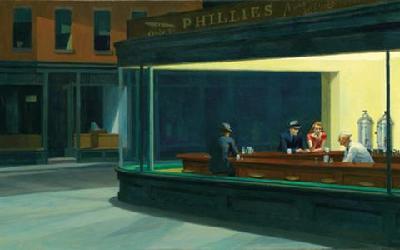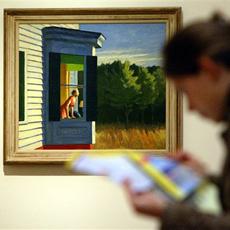
SHIRLEY GRIFFITH: I'm Shirley Griffith.
DOUG JOHNSON: And I'm Doug Johnson with PEOPLE IN AMERICA in VOA Special English. Today we tell about artist Edward Hopper. He painted normal objects and people in interesting and mysterious ways.
(MUSIC)
SHIRLEY GRIFFITH: In June of 2006, visitors entered the redesigned Smithsonian American Art Museum in Washington, DC for the first time. When these people walked into the building, they saw two simple, colorful paintings. These paintings showed normal scenes from American life. But they looked mysterious and beautiful. American artist Edward Hopper painted both of these famous pictures.
DOUG JOHNSON: Edward Hopper was born in 1882 in Nyack, a small town in New York state. From a young age, Edward knew he wanted to be a painter. His parents were not wealthy people. They thought Edward should learn to paint and make prints to advertise for businesses. This kind of painting is called commercial art. Edward listened to his mother and father. In 1900, he moved to New York City to study commercial art. However, he also studied more serious and artistic kinds of painting.
SHIRLEY GRIFFITH: One of Hopper's teachers was Robert Henri, a famous American painter in the early 20th century. Henri was a leader of a group of artists who called themselves the Ashcan School painters. The Ashcan artists liked to paint normal people and objects in realistic ways. Henri once expressed his ideas about painting this way: "Paint what you feel. Paint what you see. Paint what is real to you."
Edward Hopper agreed with many of these ideas about art. He told people that Henri was his most important teacher.
DOUG JOHNSON: Hopper studied with Henri in New York City for six years. During those years, Hopper dreamed of going to Europe. Many painters there were making pictures in ways no one had ever seen before. Many of them had begun to paint pictures they called "abstract." The artists liked to say these works were about ideas rather than things that existed in the real world. Their paintings did not try to show people and objects that looked like the ones in real life. Most American artists spent time in Europe. Then they returned to the United States to paint in this new way.
SHIRLEY GRIFFITH: With help from his parents, Hopper finally traveled to Europe in 1906. He lived in Paris, France for several months. He returned again in 1909 and 1910.
Unlike many other people, however, Hopper was not strongly influenced by the new, abstract styles he found there. "Paris had no great or immediate impact on me," he once said. At the end of these travels, he decided that he liked the realistic methods he had learned from Robert Henri.
(MUSIC)
DOUG JOHNSON: When Edward Hopper returned from Paris for the last time, he moved into a small apartment in the Greenwich Village area of New York City. He took a job making prints and paintings for businesses. However, the paintings he made outside of his job were not helping him earn money or recognition. He had a show of his work at a gallery in New York. However, most people were not interested in his simple, realistic style. Very few people bought his paintings.
SHIRLEY GRIFFITH: Things began to improve in 1923. He began a love relationship with an artist named Jo Nivison. Soon they married. His wife sometimes said that Edward tried to control her thoughts and actions too much. However, most people who knew them said they loved each other very much. They stayed married for the rest of their lives. Also, Jo was the model for all of the women in Hopper's paintings.

Success in art soon followed this success in love. In 1924, Hopper had the second show of his paintings. This time, he sold many pictures. Finally, at age 43, he had enough money to quit his job painting for businesses. He could now paint what he loved. Edward and Jo bought a car and began to travel around the country to find interesting subjects to paint.
(MUSIC)
DOUG JOHNSON: Most people say that Hopper's 1925 painting "The House by the Railroad" was his first mature painting. This means that it was the first painting that brought together all of his important techniques and ideas.
"The House by the Railroad" shows a large, white house. The painting does not show the bottom of the house. It is blocked by railroad tracks. Cutting scenes off in surprising ways was an important part of Hopper's style. He became famous for paintings that are mysterious, that look incomplete or that leave viewers with questions.
Shadows make many parts of the home in "The House by the Railroad" look dark. Some of the windows look like they are open, which makes the viewer wonder what is inside the house. However, only dark, empty space can be seen through the windows. Strange shadows, dark spaces, and areas with light were important parts of many Hopper paintings.
There are no people in the painting, and no evidence of other houses nearby. Hopper was famous for showing loneliness in his art. People often said that, even when there were many people in his paintings, each person seems to be alone in his or her own world.
SHIRLEY GRIFFITH: During the great economic depression of the 1930s, many people saw Hopper's lonely, mysterious paintings of everyday subjects. They liked the pictures because they seemed to show life honestly, without trying to make it happier or prettier than it really was. As a result, Hopper continued to sell many paintings during those years, even though most Americans were very poor.
DOUG JOHNSON: In 1942, Hopper painted his most famous work, "Nighthawks". The painting shows four people in an eating-place called a diner late at night. They look sad, tired, and lonely. Two of them look like they are in a love relationship. But they do not appear to be talking to each other. The dark night that surrounds them is mysterious and tense. There is no door in the painting, which makes the subjects seem like they might be trapped.
Hopper painted "Nighthawks" soon after the Japanese bomb attack against the United States at Pearl Harbor in Hawaii. Many people thought the painting showed the fear and unhappiness that most Americans were feeling after the attack. The painting became very famous. Today, most Americans still recognize it. The painting now hangs in a famous museum in Chicago, Illinois.
SHIRLEY GRIFFITH: "Nighthawks" was not Edward Hopper's only great success. In 1950, he finished a painting called "Cape Cod Morning." It shows a brightly colored house in the country. In the middle of the painting, a woman leans on a table and looks out a window. She looks very sad. However, nothing in the painting gives any idea about why she would be sad. Today this painting hangs in a special place in the Smithsonian American Art Museum in Washington. It is one the paintings we noted at the beginning of this program.
(MUSIC)
DOUG JOHNSON: Edward Hopper began to struggle with his art during the 1950s and 1960s. He had trouble finding interesting subjects. When he did find good things to paint, he struggled to paint them well.
At the same time, the artistic community became less interested in realistic paintings. In the 1950s, the Abstract Expressionist style became very popular. These artists refused to have subjects to paint. They wanted to "paint about painting" and "paint about ideas." They thought Hopper's style was no longer modern or important. As a result, the paintings he did complete met less success than during the earlier years.
Edward Hopper died in 1967. His wife Jo died less than a year later.
Many years after his death, Hopper's work is still popular in this country and outside America. In 2004, the famous Tate Art Gallery in London had a show of his paintings. This show brought the second-largest number of visitors of any show in the history of the museum. Today, people say Edward Hopper was one of the best American artists of the 20th century.
(MUSIC)
SHIRLEY GRIFFITH: This program was written by Sarah Randle and produced by Mario Ritter. I'm Shirley Griffith.
DOUG JOHNSON: And I'm Doug Johnson. You can read, listen to and download this program at our Web site, voaspecialenglish.com. Join us again next week for PEOPLE IN AMERICA in VOA Special English.
THE MAKING OF A NATION: Great Depression/Arts & Culture
Leonardo da Vinci: one of the greatest thinkers in history
Winslow Homer, 1836-1910: America's greatest painter of the 19th century
Painter takes art therapy to young people in Uganda
(来源:VOA 编辑:崔旭燕)
